DEGREES OF COMPARISON OF ADJECTIVES In English, as in Russian, ...

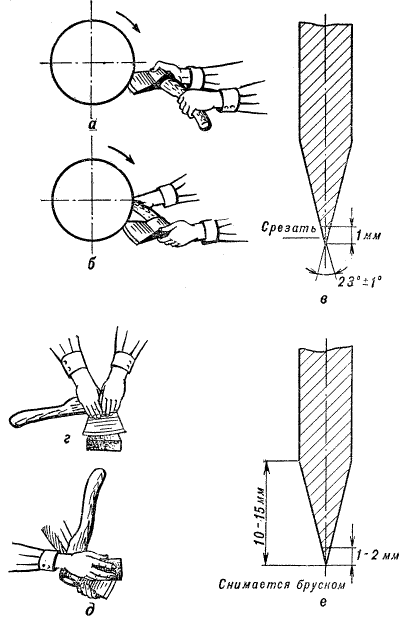
Carpentry with an ax and a saw requires precise movements and strong hands. A lot can be done with a heavy and reliable tool if the ax is sharpened according to all the rules of locksmith science. As with any tool, you need to get used to it, try out the balance and adjust the handle to the size of the brush, and most importantly, check the quality of the metal on the blade that you plan to sharpen.
It is best if a metal ax head with the stamp of the factory of the 40-50s is found for the auxiliary tool. The worst option would be a Chinese spill ax, of which there are many sold in the markets today. Sharpening a raw metal blade is a hopeless and pointless occupation.
Before sharpening the blade, it is necessary to inspect and assess the condition of the ax. This will require:
Note! After a few minutes, thin hairs of cracks and punctures can be seen on the surface of the ax, at the same time, read and photograph the brand.

If the ax is in order, the developing solution must be washed off and the blade should be sharpened.
Most often, the ax blade is sharpened with a cleaver or wedge. A thinner version of sharpening with a reverse curvature of the blade, as a rule, is made to order on forged axes. Used for light carpentry work.
Sharpening with a cleaver is more suitable for an economic option. The maximum that can be done with an ax with such sharpening is to chop branches or dry firewood. Wedge sharpening is performed in 90% of sold axes. Most often, the blade angle laid down by the manufacturer gives a very wide cutting edge, so it has to be reduced to a more obtuse angle of 22-25 o.
To restore the sharpness of the cutting edge of the ax, you can use a specialized sharpening stand or a conventional garage electric sharpener.
But before starting to sharpen the ax, it is necessary to select a machine with an engine power of at least 1 kW, an abrasive wheel diameter of 250 mm and a rotation speed of at least 1200 rpm.
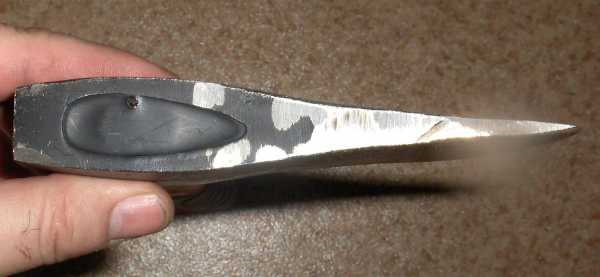
A conventional electric grinder with an engine power of 0.6 kW is suitable for sharpening knives, mower blades, chisels and other lightweight tools. Sharpening an ax on such a machine will take several hours of tedious work. An exception may be tourist and hiking options with a blade size of no more than 7-8 cm.
The correct location of the ax in the process of sharpening relative to the stone can be seen in the photo. The blade of the tool is located at an angle of 45 degrees to the plane of rotation of the stone. The rotation of the circle is assumed to be clockwise.
Sharpening an ax requires removing large enough volumes of metal, hands get tired quickly. Therefore, if the sharpener is equipped with a support table, it is necessary to set it at an angle to the circle so that the normal to the circle of the stone and the vertical make up the required sharpening angle of 25 o.
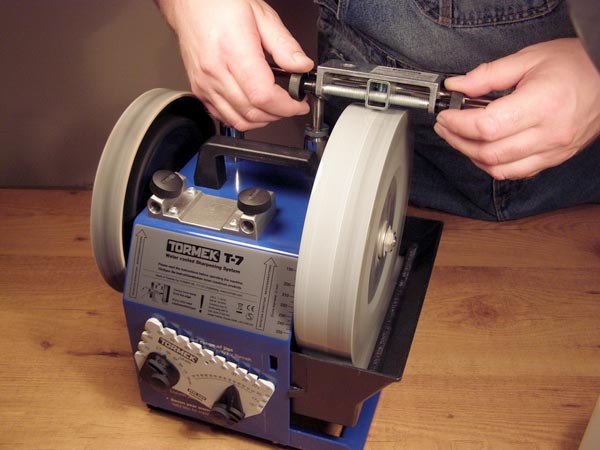
The sharpening process requires longitudinal movement of the ax blade along the end of the circle with a small pressing force. You can’t press hard, you can “fail” the plane of the wedge, with little effort the ax will become very hot.
Important! If yellow sparks do not fly out from under the stone during sharpening, this may indicate a low quality of the metal.
In addition to the sharpener, you can use the machine shown in the photo to sharpen the ax. The advantage of this scheme is the very precise geometry of the blade and cutting edge, which is difficult to achieve when sharpening by hand.
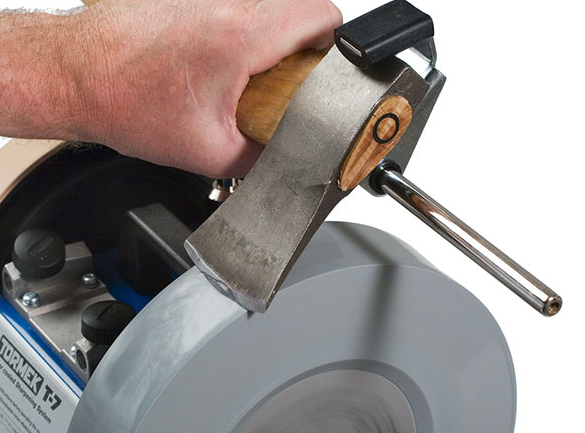
At the final stage, the sharpened surface must be finished on a fine emery cloth, first with a “one”, and then with a “zero”. To process the blade of an ax, the skin is wrapped on a wooden block. The blade is moistened with water and successively, with a little effort, smoothed with a bar to the state of a mirror. In some cases, the process is completed by polishing the ax on a felt wheel with GOI paste.
After polishing, all the failures and shortcomings made during sharpening become very clearly visible. Therefore, especially critical areas of the heel and toe of the ax are marked with a marker and re-finished on the grinder. This time, the angle is additionally controlled with a V-shaped template cut from an aluminum plate.
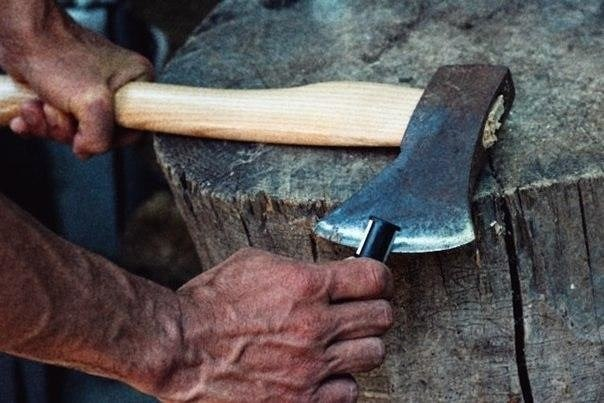
At the end of the work, the sharpened surface can be covered with an oil stone or a mixture of candle paraffin and spindle oil.
Unlike a hard ax blade, the cutting edge of a saw or wood saw is more difficult to repair due to several factors. Simple sharpening of the side surface of the teeth, as a rule, does not give the desired result. The ease with which a serrated saw blade can cut through wood depends on several factors:
Note! It is possible to identify idle teeth by the characteristic gloss of the outer surface of the cutting edge; instead of cutting wood fibers, friction occurs with partial polishing of the metal surface.
To perform a divorce, it is enough to lay a hacksaw blade between two metal or wooden planks and clamp the entire package in a metal vise. Next, the saw teeth are sequentially and alternately bent to the left and right by the amount of divorce. If the canvas is designed for cutting relatively hard wood, a tip deviation of 1-1.5 mm is sufficient. For softer poplar, birch and fruit trees, a 1.7 mm divorce is used; for raw pine or spruce, the divorce can be increased by 15-20%.
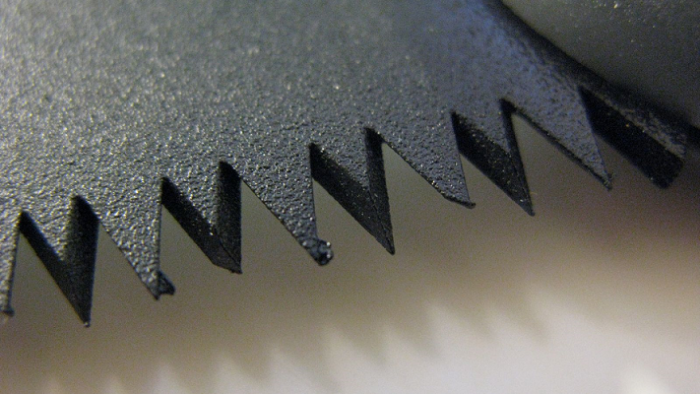
When breeding teeth, not the entire profile is rejected, but only the upper 2/3 of the tooth height. After completion of the procedure, it is necessary to check its quality. If you look at the hacksaw blade along the blade to the light, a correctly executed winding will be represented by two rows of tooth tops.
The procedure for sharpening the cutting edges of the tooth is performed using a trihedral file with a fine notch. To obtain the correct profile of the cutting edge of the tooth, the blade is clamped between two wooden planks so that the lower edge protrudes 1.5-2 cm above the end of the bar. A package of two planks and a hacksaw blade is installed and fixed on a workbench at an angle of 40-45 ° to the table plane, as in the photo.
![]()
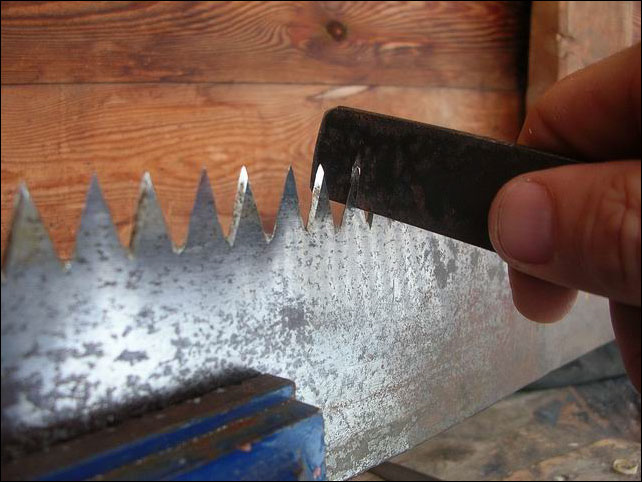
Initially, the edges of the far row are sharpened. A file or a trihedral file is directed at an angle of 60 o to the top of the tooth. The result should be a slope of the cutting edge towards the inside towards the outer surface. At the same time, there is no need to try to sharpen the edge of the tooth along its entire height; in fact, only the upper half of the tooth is involved in the process of cutting wood fibers.
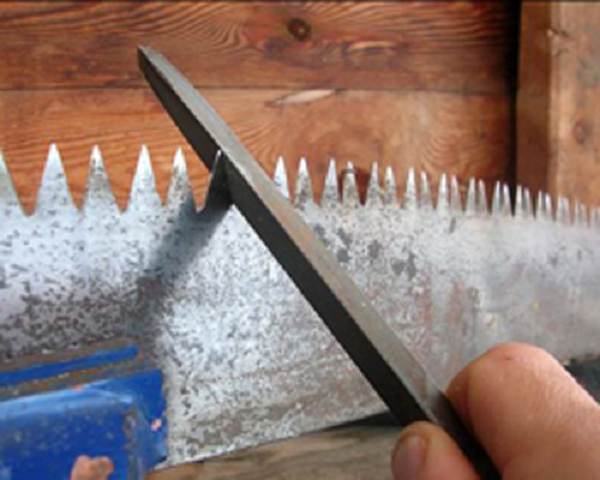
After the blade is turned over, and the far row of teeth is reground in the same way. The saw is considered properly sharpened if the cutting force does not exceed 6-7 kg, and the cutting width is two thicknesses of the blade. For two-handed saws, both edges of the tooth are sharpened to the full height of the profile.
With regular divorce and sharpening of the cutting edges, certain skills and an eye develop. The need for sharpening can be determined by the nature of the rounding on the edges and top of the tooth. Experienced craftsmen are able not to regrind the entire row, but to correct “by eye” some teeth that have lost their divorce and sharpen the cutting edge. For an amateur, this level of skill is usually not available, so it's easier to use grinding machine or sharpen in the traditional way.
To split wood, you need a sharp axe. Sharpening the ax should be done regularly, as the sharpness of the cleaver loses. Since the tool can become dull in the process of work, it is not always possible to give it to the workshop for sharpening or call the grinder to the place. A dull ax is extremely dangerous for the person who uses it. It can slide off logs or logs, because of which a person risks serious injury to himself. When working with a blunt tool, you need to apply a much greater force than when using a properly ground one.
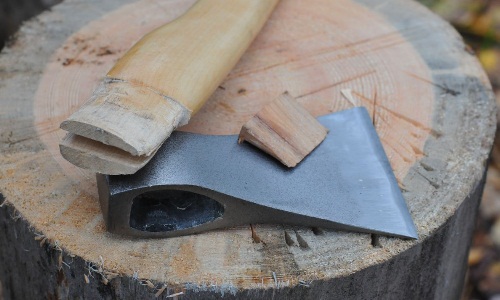
Regardless of how much the ax costs and what metal it is made of, after a certain time it must be sharpened.
An ax is needed for cutting and finishing wood. It is often made of carbon steel, and impact-resistant plastic or wood is used for the ax handle. Axes are divided into types according to their purpose:
Thus, before sharpening the blade, you should determine the type of tool, as well as what kind of wood will be processed. For example, hardwoods eat up edges faster, so resharpening should be done regularly.
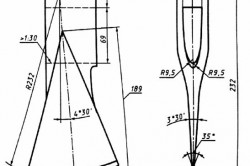
The density of the tree also depends on the humidity. The more moisture saturated the material, the more difficult it is to process. You should pay attention to the steel grade from which the tool is made.
It is also important what work will be done by the tool.
Depending on the tasks and type of ax, sharpening is carried out in various shapes. There are three main forms of tool sharpening:
The form of sharpening is selected based on the tasks that are assigned to a particular worker. For domestic purposes (chopping firewood, cutting down a tree), preference should be given to a direct form. It will save energy in the process.
Back to index
Before sharpening an ax, you should decide on the angles of sharpening. The angle of sharpening and the size (width) of the chamfer are the main necessary characteristics that determine the sharpness of the ax.
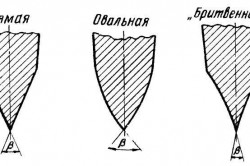
Ax sharpening forms: B - blade thickness.
The angle of sharpening is selected for a specific job. For example, trimming logs requires a very sharp corner(no more than 20 degrees).
In addition, an ax for chopping firewood from different types of wood is sharpened at different angles. So, acacia is a hard material, therefore, the angle should be more obtuse.
For homework, the ax is sharpened with their own hands at an angle of 25 or 30 degrees. Such an angle will allow you to split the log and perform small tasks in processing the material.
For example, if you need to trim a small section of the workpiece.
To perform more accurate work, you should give preference to angles of 15 - 20 degrees.
If you sharpen the tool at such an angle, it will make it possible to carry out rough wood finishing, accurately and accurately trim the workpiece, or use a tool for minor furniture repairs.
Back to index
The width of the chamfers significantly affects the sharpness of the product and the life of the blade until the next turning operation. However, changing the chamfer at home is much more difficult than sharpening an ax. Resizing the bevel requires much more work time and physical effort applied to the blade in the process. Although this procedure is not much different from sharpening.
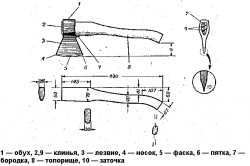
Chamfer is the distance from the axis of the blade to the plane of the ax. In the people it is called descents. Well-chosen sizes of descents can often be found on some branded axes or products of homemade blacksmiths. Such products do not require alteration, which makes it easy to maintain the sharpness of the blade.
In order to change the dimensions of the chamfers, you should remove excess metal from the ax to the required size. In the past, a method called "blade pull" was common.
The tool “eaten” by constant regrinding was processed by a blacksmith who made new chamfers. In this case, the product became lighter and smaller than the original, but received a second life.
Since many modern manufacturers hack and use low-quality metal, bevel rework has become ubiquitous. So that the quality of the metal does not have a significant impact on the cutting process, chamfers with different angles are used. So, one descent is made at an angle of 15 degrees, and the second - at 25 degrees.
Back to index
To sharpen a tool with your own hands, maximum concentration is required.
To sharpen the tool, you will need several whetstones with different grain sizes, a piece of leather (ideally a leather belt), water and a cloth.
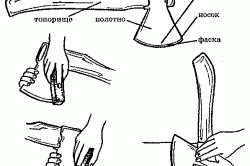
The first step is to determine the shape and degree of severity. This can be done by eye, or you can use various improvised devices for this. The most commonly used wooden block, one of the corners of which is equal to the angle of sharpening. The second device is a yew, in which an ax, a protractor and a long grindstone are clamped. The protractor is applied to the stone and set the desired angle, then oriented to the plane of the ax.
The process of sharpening (forming a burr) is quite simple. To sharpen the ax, a semi-circular motion is made with a coarse-grained grindstone at a given angle, slightly pressing on it. This process is carried out on 2 sides of the blade. When the metal layer is removed, the same is done using a stone of medium grain size. And then again, but already with an almost smooth stone. At the end of the work, the blade is ground on the skin in the same way as sharpening. For better control of the process and its acceleration, the stones and the blade are moistened with water, and the dirt and chips are removed with a cloth.
Grinding machines can also be used for sharpening. To do this, they are equipped with grinding discs of the desired grain size. After starting, blades are brought to them. It is especially difficult to maintain the angle and eliminate the beating. It is necessary to maintain the corners by eye, the use of various devices for this on the machine is impossible. Beating significantly affects the quality of sharpening, which can become “toothed” (with sharp shocks). Beats appear involuntarily when the blade touches the rotating stone and when the blade moves along the stone. For their exclusion and prevention, experience in carrying out such procedures is necessary.
An important point is the so-called dryness of steel. Scientifically, this is called hardening. The drier the steel, the better the axe. However, "dry", hardened steel can crack and chip. To prevent this, it is necessary to sharpen slowly and gently, without sharp and quick strokes and movements. To determine if the ax is hardened enough, you should tap on the metal with your fingernail and listen for the sound. The longer the impact sound lasts, the drier the steel.
Do not use angle grinders (grinders) for sharpening axes. They cannot fully control the angle and the sharpening process, in addition, the grinder also removes the burr (which gives sharpness). Many people do this because of the beauty of the process (sparks fly like fireworks), but such experiments will not only not sharpen the blade, but will quickly render the ax unusable.
A specialized electric grinder will help sharpen tools most effectively. This is a small compact machine that has several devices for holding angles during sharpening and several simultaneously working stones of different grain sizes. It is very beneficial to use such devices if you have to sharpen a lot and often (not only axes).
An ax is a tool that accompanies a person in his life for millennia. These products are stone, bronze, iron. Nowadays, an ax is used for the manufacture of various structures made of wood, for harvesting trees. This tool consists of a metal blade that is rigidly attached to a wooden handle. Of course, over time, any blade will become dull. How to sharpen an ax correctly so that you can use it effectively?
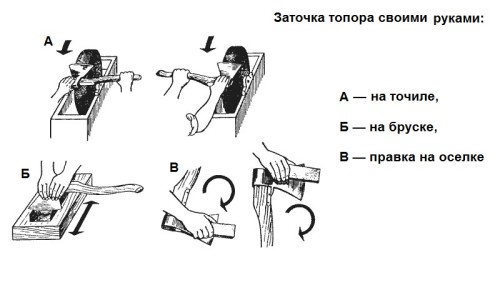
The main details of an ordinary ax:
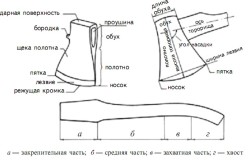
General view and name of the parts and details of the ax.
The blade of the tool is made of high-quality steel, which contains more than 0.7% carbon. This is a tool steel of various grades. Steel containing various impurities (phosphorus, oxygen, sulfur) has a much shorter service life. A high quality metal tool is marked with the letter A.
Ax types:
The butt of multifunctional products can be made in the form of a pick, a nail puller, a hammer. They are great for small jobs.
The most common type is the universal axe. It is otherwise called carpentry. The chopping part of the ax is characterized by a straight shape. They are used by professional joiners and carpenters, home craftsmen. Joinery and carpentry tools differ in different sharpening angles.
A cleaver is a special heavy axe. It is used for chopping wood. Its blade is like a wedge. It does not usually get stuck in wood. The long ax greatly enhances the blow.
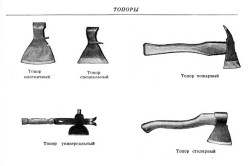
The lumberjack variety is lighter, indispensable when cutting trees in the forest, when cutting branches from the trunk. The usual weight of such a tool is more than 2 kg. But there are also lightweight specimens, weighing 1-1.5 kg.
The tourist camping ax differs in small weight and compactness. It is used outdoors during hikes and picnics for preparing fuel for a fire, for setting up a tent.
Back to index
This product is irreplaceable when performing various works in the country, during the construction of buildings, greenhouses and hotbeds. Any tool loses its sharpness over time. How to sharpen an ax yourself? For proper sharpening, you can:
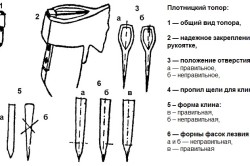
The device of a carpenter's ax.
The angle of sharpening the blade of a construction ax is usually 20-30°. Carpentry tools are sharpened at an angle of 35°. The sharper it is, the less force you need to apply when doing any work.
But at a small angle, the tool can become dull very quickly and get stuck in the workpiece.
Therefore, cleavers are sharpened at an angle of 35-40°, woodcutting axes - at an angle of 25-30°.
You can sharpen the ax yourself manually, you can use an electric grinder for this operation, which is a rotating circle. For proper sharpening you will need:
The procedure for using an electric grinder is approximately as follows:
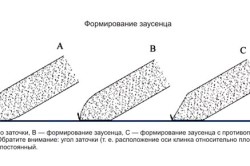
Sharpening an ax - forming a burr.
Special devices for sharpening axes by hand can be bought. The Smith´s 50118 sharpener has proved to be excellent. In a few broaches, it makes any blunt ax sharp. It is completely safe to use this device. It uses premium carbide elements as an abrasive. The kit includes a special brush for cleaning the tool. It is stored in the handle.
The simplest device used for manual sharpening is an ordinary abrasive wheel. You can use a bar. To perform such sharpening you will need:
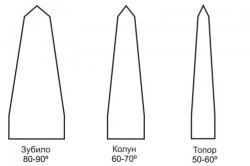
Operating procedure:
To increase the productivity of carpentry, it is important that the ax is properly prepared - this is clear to everyone. However, just a sharp ax will not make you a "forerunner of socialist competition." It should be not just sharp, but CORRECTLY sharpened. Let's figure out how to do it, and what is right ax for different purposes.
When preparing an ax for use, two points must be taken into account: the angle of sharpening and the width of the chamfer. Everyone chooses the optimal sharpening angle for himself, based on personal experience. The fact is that choosing the right angle depends on four main factors:
Therefore, only "average" recommendations for the angle can be given. If you need to cut dry wood, then the angle should be done within 25 - 30 degrees. For trimming a freshly cut tree, an angle of about 20 degrees is best. Just keep in mind that the smaller the angle, the faster the ax will become dull.
The width of the chamfer also affects the performance of the axe. However, it is rarely changed. This is done by forging metal. Previously, a method such as "blade pull" was used. The worn-out ax was carried to the blacksmith, and he gave him a “second youth”. Modern production does not "trouble" itself with good forging. Therefore, people's ingenuity suggested another option. The ax is sharpened with a double "descent". The first angle is about 15 degrees, and the point itself (the second angle) is sharpened to an average value (25 degrees).
The sharpening process itself requires utmost attention. When using an electric grinder, the process takes little time, but the metal overheats, which does not have the best effect on the hardness of the cutting-piercing part of the ax. Therefore, the first thing you need to take care of is to reduce the beating of the grinding wheel to a minimum. In the process of sharpening, it is necessary to constantly monitor the state of the surface of the circle and regularly “edit” it. Only in this case can sharpening be done with high quality.
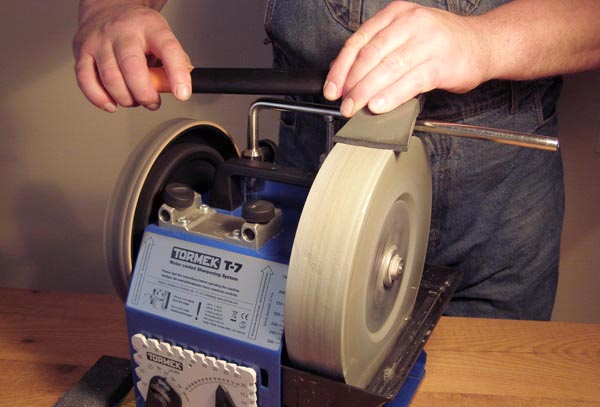
Much depends on how you hold the ax while sharpening. Its blade should be directed towards rotation, and the butt should be kept at an angle of 45 degrees. During sharpening, you should smoothly move the ax along the surface of the “grindstone”, achieving a thorough grinding of the chamfer. Do not forget about overheating. It is advisable to submerge the ax in water after each "pass" from edge to edge.
The ax is “finished” with the help of a bar, which is constantly moistened with water. It is necessary to ensure that the blade is sharpened equally on both sides.
Finally, a video - how NOT to sharpen an ax:
For fast and high-quality chopping of firewood, you must have a sharp ax. Over time, its sharpness is lost. Therefore, you should regularly sharpen the ax. This procedure can be performed either with the help of a special master, who is called to the house, or with your own hands. A blunt tool for sharpening an ax can harm human life and health. First of all, during splitting, it can slip off the log and cause serious injury to a person. When working with a blunt tool, more force must be applied to achieve the goal than with a sharp one. Sharpening an ax must be carried out in compliance with certain rules.
An ax is a special tool that is used for processing or cutting wood elements. Such a device consists of three elements: a sharpened blade, a fixing wedge and a handle. The last element is usually made of wood. The blade is made from various kinds steel that contains more than 0.7% carbon. This condition must be fulfilled. As a metal, both special types and ordinary ones are used. These two types of metals differ in the amount of impurities. In the first one, their content is higher. In the production of metal, as a rule, phosphorus, sulfur, oxygen, etc. are added. Stab objects made of ordinary metals have a short service life. Therefore, when choosing an ax, you should pay attention to the markings. The letter A means that the metal of the highest standard and will last longer.
Before buying a tool, you also need to determine its destination. 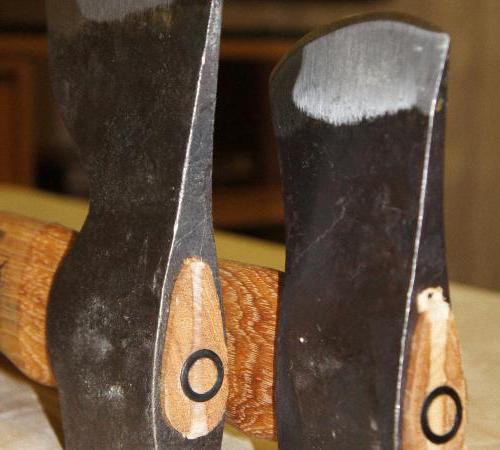 A properly selected ax helps save time and effort, as well as perform the task with high quality.
A properly selected ax helps save time and effort, as well as perform the task with high quality.
There are such types of axes:
As mentioned earlier, it is an important construction tool that is used to perform various types of work with wooden structures.  After the acquisition, it is necessary to sharpen it. This procedure will still have to be carried out, regardless of the quality of the factory sharpening of the ax. It's better to spend some time sharpening your blade than to struggle with a dull tool later.
After the acquisition, it is necessary to sharpen it. This procedure will still have to be carried out, regardless of the quality of the factory sharpening of the ax. It's better to spend some time sharpening your blade than to struggle with a dull tool later.
Before you start sharpening the device, you need to make a template according to the following scheme:
The ax is sharpened after studying the following factors:
When performing factory sharpening, only the last two factors are taken into account.
Before performing this operation, it is necessary to determine the desired angle. The final sharpness of the blade is influenced by factors such as the size of the bevel and the angle of sharpening. The last characteristic is selected depending on the type of intended work.  To cut or trim wood, use a sharp corner. This indicator can be no more than 20º. Also study the characteristics of the proposed tree. For harder rocks, an obtuse angle should be used.
To cut or trim wood, use a sharp corner. This indicator can be no more than 20º. Also study the characteristics of the proposed tree. For harder rocks, an obtuse angle should be used.
At home, as a rule, the blade is sharpened at an angle of 25 to 30º. This is enough to perform small woodworking tasks (such as splitting logs or cutting down small trees). For more precise work, experts advise using an angle of 15 or 20º. Sharpening at these parameters will help to finish the wood. This technique is used in the manufacture of individual pieces of furniture.
This characteristic affects the sharpness of the ax blade, as well as the life of the tool. However, it is very difficult to change this indicator at home, compared to choosing the sharpening angle. To change the width of the chamfers, you must apply a significant amount of physical strength and spend a lot of time. The procedure is no different from ordinary sharpening.
Chamfer is the distance from the axis of the blade to the surface of the axe. In some sources, you can find such a name as descents (although this is the same thing). The correctness of the selected sizes can be found at well-known manufacturers or noble masters. 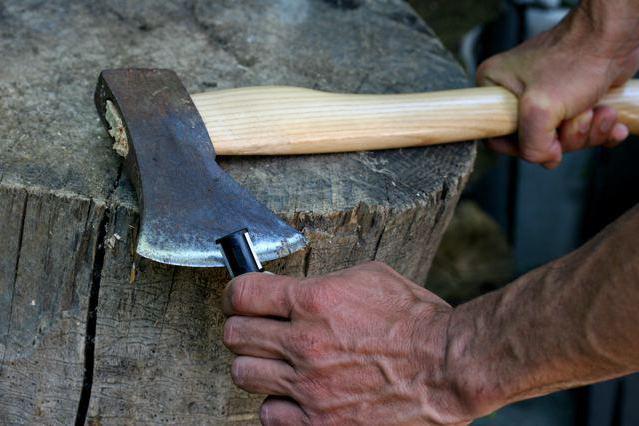 At the same time, such a tool does not need to be redone, and sharpening the blade is quick and easy.
At the same time, such a tool does not need to be redone, and sharpening the blade is quick and easy.
So, to change the size of the descents, it is necessary to remove an excess amount of metal from the ax to a certain size. For this, a method such as a pull blade is used. This is an ancient and still common method, which consists in constant regrinding. The end result is a lighter tool, which greatly simplifies the work. 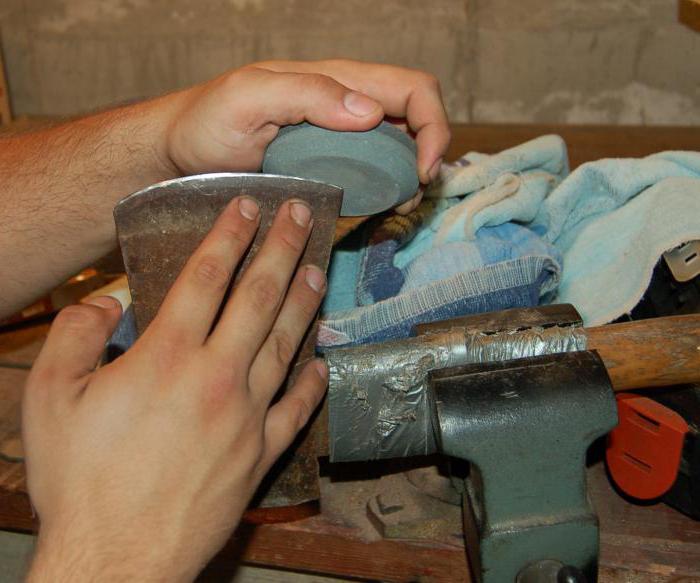 Most manufacturers use low-quality metal in the manufacture of the blade, so changing the size of the bevels has become commonplace. In order for the cutting quality to be higher, the dimensions of the sides should be slightly different.
Most manufacturers use low-quality metal in the manufacture of the blade, so changing the size of the bevels has become commonplace. In order for the cutting quality to be higher, the dimensions of the sides should be slightly different.
In order not to constantly contact special workshops, this procedure is performed at home. Tools for sharpening an ax are bought in a store or made independently. The most common method is grinding with an abrasive wheel. This device is fixed between two wooden beams. Moreover, the angle of their installation is determined by geometric rules. is the hypotenuse, and the bars are legs. The circle is fixed at a certain angle. The ax blade is held vertically and driven along the horizontal plane of the circle.
Sharpening an ax can be done in another way, however, for this you need to purchase some additional tools:

The work is performed in the following sequence:
So, we found out how the ax is sharpened. As you can see, this procedure can be performed with your own hands.